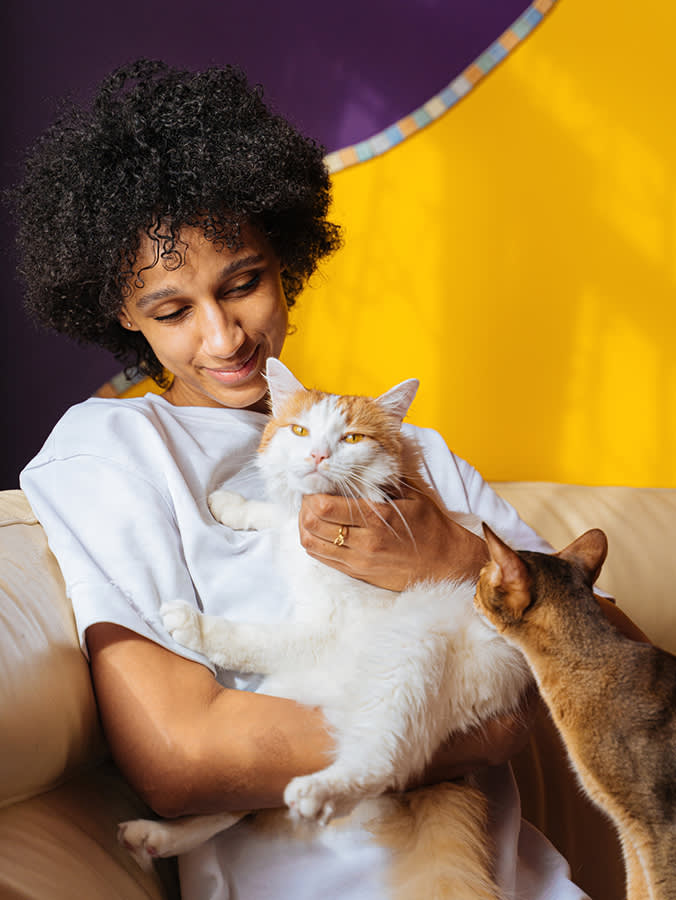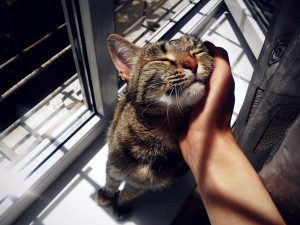How to Build Your New Cat’s Trust in You
If your cat still approaches you with a figurative arched eyebrow of skepticism, try these tricks to put them at ease.

Share Article
It’s fair to call most cats high maintenance, but we both love and accept that about them. As Chandler famously said to Monica on Friends: “It’s OK, because I like...maintaining you.” A big part of that maintenance puzzle is winning your cat’s trust. Your cat wants to trust you but needs constant reassurance that you are deserving of their confidence in you. You are obviously deserving; convince your cat of that fact with these trust-building ideas.
Respect your cat’s space.
Being a space invader is a common way to lose out on a cat’s good feelings toward you. Allow your cat to come to you rather than charging toward your cat or picking them up. Go at your cat’s pace when it comes to physical contact. Let them approach you and make the first move.
Learn how your cat likes to be touched.
Most cats enjoy pets behind their ears, on the chin and cheeks, and on the back of the neck. The spot where the tail connects to the body is another place many cats appreciate some affection. The gentle pressure of your fingertips and wiggling motions of your fingers are a good way to pet most cats; they usually prefer that approach to long strokes. Generally speaking, cats don’t enjoy rough pressure, having their belly rubbed, their feet touched, or being pet against the grain, which fluffs up their fur (the mohawk look is not for them).
Create positive experiences with them daily.
Trust is built from positive experiences, so create them every day with your cat. Playing with cats is one of the best ways to establish trust. Use toys they find engaging — best bets are ones that move so they can chase them or jump up to reach them.
How much do you spend on your pet per year?

Let them frequently “catch” the toys they like so they don’t feel as if you are teasing them. Training should be a positive experience, too. When cats learn they can offer you certain behaviors in response to cues and that you will, in turn, give them delicious treats, their trust in you will grow.
Pay attention to their body language and act accordingly.
If you notice that your cat appears tense, afraid or on edge, and you don’t approach them, that prevents you from violating your cat’s trust. If you only interact with your cat when they are relaxed and comfortable with what you are doing, it’s easier to build trust between the two of you. Knowledge of their body language allows you to react properly in any interaction with your cat, whether that means playing, petting, or grooming.
Be predictable.
Cats are not usually big on surprises, so keep things predictable. If they are used to you walking by and continuing to move when they are eating, don’t change it up by stopping to offer any affection. If your usual pattern is to let them jump into your lap when you sit on the couch, don’t act differently by rushing it and picking them up to put them there.
Allow your cat access to places where they know nobody will disturb them.
Offer your cat places to be where they are guaranteed to be undisturbed by others in the household, such as bookshelves, cat trees, a box, or even a particular cushion. If they know they have an escape route when anything troubles them, and you respect their desire to have a little alone time, that builds trust.
Avoid setbacks.
It’s so much easier to build trust than to rebuild it after a setback in which the cat’s confidence in you has been lost. So, it’s wise not to do things that upset your cat; that erodes trust and makes mending the relationship more challenging. Avoid moving too quickly or startling your cat. If you know your cat does not like to be picked up, don’t pick them up. Similarly, if your cat gets upset by anyone approaching when they are using their litter box, leave them alone when they are taking care of business there.
Many of our feline friends subscribe to the famous Russian proverb, “Trust, but verify.” Their confidence in you is subject to review, so don’t ever stop your efforts to build and maintain trust. That’s how to make certain the famous Friends theme song, “I’ll Be There For You” (complete with requisite clapping), becomes the soundtrack of your relationship.

Karen B. London, PhD, CAAB, CPDT-KA
Karen B. London is a certified applied animal behaviorist (CAAB) and certified professional dog trainer (CPDT) who specializes in working with dogs with serious behavioral issues, including aggression. She has written for a variety of magazines including The Bark, Clean Run, and the APDT Chronicle of the Dog, and has published in scientific journals including Behavioral Ecology and Sociobiology, Ethology, Ecology, and Evolution, the Journal of Insect Behavior, and Insectes Sociaux. She is the author of seven books about dog training and canine behavior, including the forthcoming My Dog's Mystery Adventure: And Other Stories From a Canine Behaviorist and Dog Trainer.
Related articles
![Black cat staring at a cat toy]()
How to Play With Your Cat
Cat behaviorist Cristin Tamburo’s got a game plan.
![Two cats walking with their tails sticking straight up]()
Cat Tail Meanings
Cats are enigmas. But their tail movements can reveal a lot about their moods.
![Cat being happily pet in the sunshine of a window]()
How to Pet a Cat (Without a Scratch)
There is a right and wrong way.
![]()
How to Read Your Cat’s Poker Face
A guide to their not-so-secret tells.
![Training a cat sitting with leash and harness on.]()
A Step by Step Guide on How to Clicker Train Your Cat
This popular training technique isn’t just for dogs. Here’s how you can use it for your cat.
![A gray cat in a tan cat carrier]()
How to Get a Cat in a Carrier
Here’s how you can train your stubborn cat to do one of their least-favorite things.










